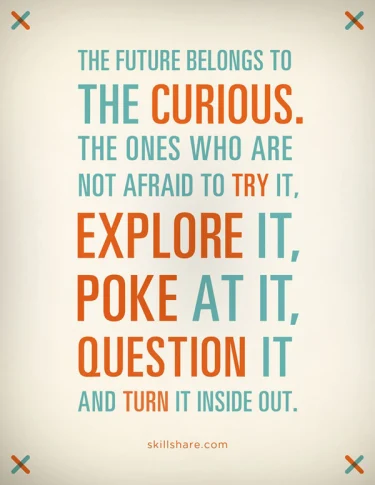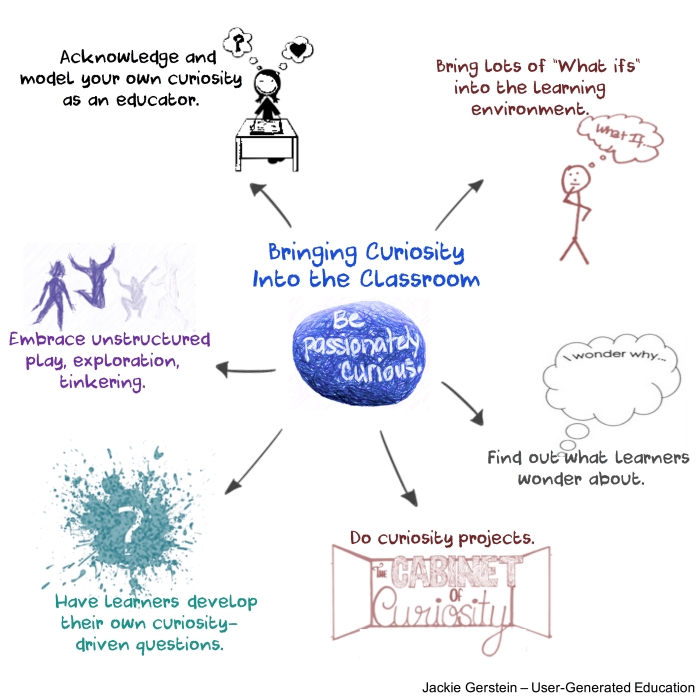The Future Belongs to the Curious: How Are We Bringing Curiosity Into School?
What is curiosity? The word is associated with the irregular form of the Latin verb cura, which can mean worry or care about or cure. The word closest in meaning is inquisitive, which also has a Latin root: quaere, to search into, to seek. (How Can Teachers Foster Curiosity?)
Curiosity is the quest for new ideas and information. Folks who are curious aren’t satisfied with what they already know or have figured out. They go after what they don’t know or can’t understand—and that missing information can become a driving need to find out. “Curiosity’s most distinguishing characteristic is its open willingness to explore….” (Cultivating Curiosity in Our Students as a Catalyst for Learning)
The future belongs to the curious . . .

A recent research study found a connection between curiosity and deep learning:
The study revealed three major findings. First, as expected, when people were highly curious to find out the answer to a question, they were better at learning that information. More surprising, however, was that once their curiosity was aroused, they showed better learning of entirely unrelated information that they encountered but were not necessarily curious about. Curiosity may put the brain in a state that allows it to learn and retain any kind of information, like a vortex that sucks in what you are motivated to learn, and also everything around it. Second, the investigators found that when curiosity is stimulated, there is increased activity in the brain circuit related to reward. Third, when curiosity motivated learning, there was increased activity in the hippocampus, a brain region that is important for forming new memories, as well as increased interactions between the hippocampus and the reward circuit. (How curiosity changes the brain to enhance learning)
So what are we doing (or not doing) in our educational institutions to encourage and spark the curiosity of learners?
Curiosity is inherently dynamic and propulsive, not sedentary and passive. Most traditional instruction depends on the latter state and seeks to control the former. This is true especially of the interrupting student or precocious child who wanders about, ignoring the lesson while remaining intent on some mission of his or her own.
The only rational answer to the conundrum of curiosity is to disengage our educational system from standardized testing and common curricula. Curiosity does not hold up well under intense expectation. Give agency to teachers, with the explicit message to slow down and provide students time to wonder and be curious. Counter-intuitively, our role as teachers is not to provide answers. Our role is to give time and free rein to inherent curiosity and questions, and let our students exist in the heightened state of hungering for knowledge. (How Can Teachers Foster Curiosity?)
In this era of overly scripted, overly tested, overly controlled students AND teachers, there seems to be little or no room for curiosity at school. So what is the cost of curiosity-void schools? The result , way too often, is a school culture of malaise rather than a culture of curiosity, engagement, excitement and joy for learning. Educators along with their administrators need to be agents of their own teaching and bring curiosity into their classrooms especially if they have the slightest belief that the future belongs to the curious.
What follows are some strategies for allowing curiosity to flourish in the learning environment:
- Acknowledge and model your own curiosity as an educator.
- Bring lots of “What ifs” into the learning environment.
- Find out what learners wonder about.
- Have learners develop their own curiosity-driven questions.
- Embrace and provide the time and setting for unstructured play, exploration, tinkering (for all ages).
- Do curiosity projects.

Acknowledge and model your own curiosity as an educator.
The first and possibly the most significant action that educators can take is tapping into the curiosity of their students is to find, embrace and use their own curiosity as an integral part of their teaching strategies.
The power of modeling and social learning cannot be overstated.
When researchers invite children into a room containing a novel object, they find that children are very attuned to the feedback of adults. When the experimenter makes encouraging faces or comments, children are more likely to explore the interesting object. Experiments I’ve done show that children show much more interest in materials when an adult visibly shows how curious he or she is about the materials. In other words, children’s curiosity can be fostered or squelched by the people they spend time with. (The Case for Curiosity)
Bring lots of “What ifs” into the learning environment.
“What ifs” are defined, in this case, as what could be, what is possible. It is about possibility thinking. “What ifs” open doors to curiosity, imagination, and divergent thinking. A classroom filed with “what ifs,” generated by both the educator and the learners, is open to all kinds of possibilities. It is not constrained by what it but is becomes a place where thinking centers on what could be.
Find out what learners wonder about.
Micheal Wesch, the acclaimed digital ethnography professor from Kansas State University, had this to say about wonder:
What is needed more than ever is to inspire our students to wonder, to nurture their appetite for curiosity, exploration, and contemplation, to help them attain an insatiable appetite to ask and pursue big, authentic, and relevant questions, so that they can harness and leverage the bounty of possibility all around us and rediscover the “end” or purpose of wonder, and stave off the historical end of wonder.
I’ve developed and implemented a What Do I Wonder About? activity that I’ve done both 1st graders, 5th graders, and even college students. I observed 100% engagement by all aged learners. Other wonder activities can be found at 4 Ways to Cultivate a Sense of Wonder (And Why it’s Important).
Not only do activities like these assist the educator in discovering what their learners wonder about, they give learners the message that what they wonder about it important and valued.
Have learners develop their own curiosity-driven questions.
Wesch believes that a sense of wonder and curiosity is nourished by learning to ask and pursue big, authentic, and relevant questions. The great educational philosopher Paulo Freire agrees with the power of the question and its direct relationship to curiosity:
I believe in the pedagogy of curiosity. That’s why I defend the pedagogy of the question and not of the answer. The pedagogy of the question is the one that is based on curiosity. Without that pedagogy there would not be a pedagogy that augments that curiosity. (The Future of School)
There seems to be lots of educational writings about how educators can use effective questioning techniques in the classroom. But these are the questions that are of interest to the teacher; that are composed and asked by the teacher. These questions may tap into the interests and curiosities of their learners, but they are may not. If educators really have a desire to open up the channels of curiosity in their learning environment, they will facilitate helping learners develop their own curiosity-driven questions. As I discussed in Learners Should Be Developing Their Own Essential Questions:
If the true goal of education is inspiring students with a lifelong capacity and passion for learning, it is at least as important that students be able to ask the right question as it is to know the right answer. (Learning To Ask The Right Question)
Embrace and provide the time and setting for unstructured play, exploration, tinkering (for all ages).
As formal educational settings have evolved (seems a bit like a misnomer), there has also been less time blocked off for unstructured play, exploration, and tinkering. It seems that most Kindergarten through graduate school education have added more and more instructional time during each day leaving less time to just play.
Everywhere we turn these days we find pundits and politicians arguing for more restrictive schooling. Of course they don’t use the word “restrictive,” but that’s what it amounts to. They want more standardized tests, more homework, more supervision, longer school days, longer school year. (Learning Requires Freedom)
If learners of all ages had more time to just play, then their natural curiosities would emerge:
Whatever happened to the idea that children [and the rest of us] learn through their own free play and exploration? Every serious psychological theory of learning, from Piaget’s on, posits that learning is an active process controlled by the learner, motivated by curiosity.
If we stop to think about it, that the most valuable lessons we have learned are not what we “learned in kindergarten,” nor what we learned in courses later on. They are, instead, the lessons that we learned when we allowed ourselves the luxury of following through on our own interests and our own drives to play, fully and deeply. (Learning Requires Freedom)
Do curiosity projects.
Educators can even do a guided curiosity project with their learners. If educators want more detailed directions or a template for bring a curiosity project into their classrooms, see https://goo.gl/8HgZ7s written and implemented by Scot Hoffman.
It is a miracle that curiosity survives formal education. It is, in fact, nothing short of a miracle that the modern methods of instruction have not entirely strangled the holy curiosity of inquiry. — Albert Einstein
Let’s change this! Let’s bring curiosity based learning into more formal education to help learners belong in the future of curiosity.
Written by Jackie Gerstein, Ed.D.
November 14, 2015 at 2:50 pm
Posted in Education
Tagged with 21st century skills, choice menus, curiosity, disrupting education, educational reform, passion-based learning, school reform
8 Responses
Subscribe to comments with RSS.
Leave a comment Cancel reply
This site uses Akismet to reduce spam. Learn how your comment data is processed.

Hi Jackie! I made the first cat just using the title of the post. More to come!
http://growthmindsetmemes.blogspot.com/2015/11/english-future-belongs-to-curious.html
And about the Latin origin of the word “curious,” there are some notes here (I used to be a Latin teacher… a long time ago!)
http://oudigitools.blogspot.com/2014/10/curiosity-or-security-what-do-you-care.html
Laura Gibbs
November 16, 2015 at 5:34 am
LOVE, LOVE, LOVE this!!! I always enjoy reading and sharing your posts. Thank you for sharing your expertise and knowledge with the world!
Michelle
November 16, 2015 at 3:26 pm
Thanks so much, Michelle!
Jackie Gerstein, Ed.D.
November 16, 2015 at 5:45 pm
We love your posts Jackie. Thanks for sharing such informative posts…
NZT Solutions Pvt. Ltd.
November 20, 2015 at 4:55 am
Thank you!!!! now I am knowledgeable, I am so curious for doing curiosity projects, regards Mrs Sanchez
guadalupe sanchez c
January 4, 2016 at 5:53 pm
Thanks, NZT Solutions!
Jackie Gerstein, Ed.D.
January 4, 2016 at 6:54 pm
Learn to live and love to learn is living make learning like food and water.
karen millhoff
August 27, 2016 at 8:32 am
[…] of learning moments that are authentic and meaningful? Take a look at the following produced by Jackie Gerstein, author of the blog User-Generated Education. If you’re not already trying some of these strategies, pick one and see what happens. […]
“Passionately Curious” | CSD Innovation Blog
March 14, 2023 at 2:52 pm